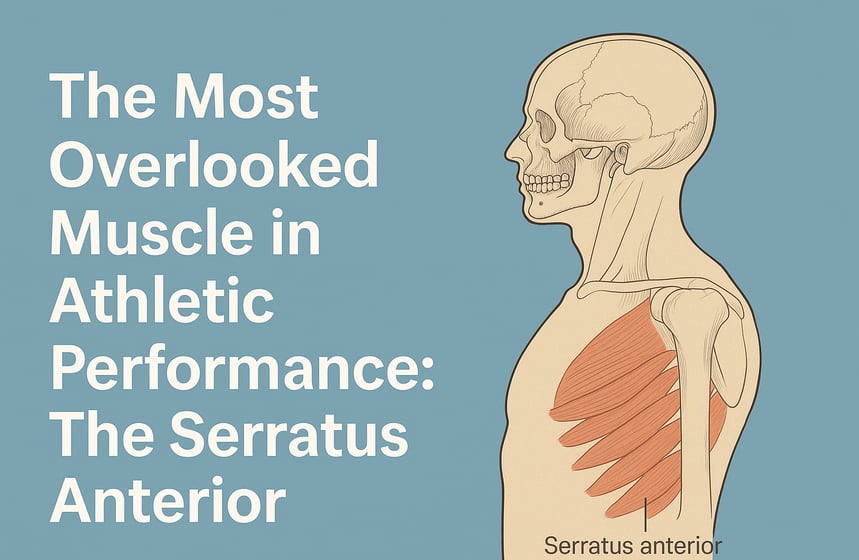The Most Overlooked Muscle for Shoulder Strength: Why Every Athlete Should Train Their Serratus Anterior
Unlock better shoulder stability, strength, and injury prevention by training the serratus anterior. Learn top exercises, expert tips, and the best tools to activate this underrated muscle.
5/27/20253 min read


The Most Overlooked Muscle in Athletic Performance: The Serratus Anterior
When it comes to athletic performance, most people talk about the glutes, the core, or maybe even the rotator cuff. But there’s one muscle that quietly holds everything together—especially for overhead athletes, lifters, fighters, and swimmers—and it barely gets the attention it deserves: the serratus anterior.
If you’ve ever dealt with shoulder instability, poor posture, or limited overhead range of motion, chances are this muscle was involved. Known as the “boxer’s muscle” for how it drives the scapula forward during punches, the serratus anterior plays a huge role in shoulder control and performance. It’s time we gave it the spotlight it deserves.
Why the Serratus Anterior Matters So Much
The serratus anterior wraps around the ribcage and connects to the scapula, basically acting like a seatbelt for your shoulder blade. Its job? To keep the scapula snug against the ribcage while also helping it rotate upward during arm movements like reaching, pressing, and throwing.
When it’s weak or inactive, your scapula wings out, your shoulder becomes unstable, and the entire shoulder complex loses its foundation. That’s a fast track to impingement, pain, and performance plateaus.
In a 2013 study in the Journal of Shoulder and Elbow Surgery, researchers found that athletes with shoulder impingement had significantly less activation in the serratus anterior than healthy controls. Even more telling: strengthening the serratus helped reduce pain and improve performance in overhead athletes.
It’s not just about rehab—it’s about next-level performance.
Common Signs Your Serratus Is Underactive
You feel unstable during overhead pressing
Your shoulder blades pop off your ribcage during push-ups
You can’t lock out cleanly during overhead lifts
You’ve had shoulder impingement or rotator cuff pain
If any of these sound familiar, your serratus anterior could be the missing link.
The Best Drills to Activate the Serratus Anterior
Here are a few of the most effective, sport-friendly exercises that target this underrated muscle:
1. Wall Slides
Stand with your back and forearms against a wall. Slowly slide your arms upward while keeping your shoulder blades pulled forward (not pinched back). Focus on a smooth glide and reaching upward through the shoulder blades.
2. Push-Up Plus
Start in a push-up position. At the top of the push-up, push your body even higher by rounding the upper back slightly—this protracts the scapula and fires the serratus.
3. Banded Dynamic Hug
Anchor a resistance band behind you at chest height. With arms out like you’re going in for a hug, bring your hands together in front of your chest. The focus is on squeezing the front of the ribcage and maintaining shoulder control.
Resistance Bands for Serratus Activation
TheraBand Resistance Band Set – Amazon
A staple in any mobility or rehab kit. These light-to-medium resistance bands are perfect for dynamic hugs, punches, and scapular retraction work.
Why it works: It allows you to scale tension, train multiple ranges of motion, and isolate weak links.
Use it for: Band punches, dynamic hugs, serratus wall slides.
Integrating Serratus Work into Training
The serratus anterior is a stabilizer first, not a prime mover. That means it responds best to volume, frequency, and control—not max effort. You don’t need to max out reps; instead, sprinkle these exercises in before your upper body days or as part of your shoulder health routine.
Try this weekly routine:
2x per week (e.g., on upper body or conditioning days)
2–3 sets of each exercise
Focus on slow tempo and full range of motion
It’s not glamorous work, but it’s the type of training that keeps your shoulders healthy long-term.
Resistance Bar for Scapular Stability
Serenilite Resistance Bar – Amazon
A flex bar that targets forearm and shoulder stability through slow, controlled rotations.
Why it works: It helps train the small muscles involved in scapular control without overloading the shoulder.
Use it for: Scapular punches, shoulder rotations, and single-arm stabilization drills.
Serratus in Real-Life Performance
This isn’t just about injury prevention. Elite athletes across multiple sports focus on serratus activation to boost performance. Olympic swimmers, pro pitchers, MMA fighters, and CrossFit competitors all rely on it to stabilize the shoulder during high-speed movements.
If you dig through performance interviews, you’ll find top coaches like Eric Cressey, Mike Reinold, and Kelly Starrett consistently programming serratus-specific drills for their athletes—because without it, the shoulder can’t do its job.
Kickboxing Resistance Bands for Dynamic Scapular Work
Spartacus Kickboxing Resistance Bands – Amazon
These full-body resistance systems allow you to simulate dynamic movements like punches and reaches.
Why it works: Great for athletes who need to build strength through movement, not just in isolated positions.
Use it for: Band punches, loaded reaches, movement prep before training.
Final Thoughts
If your goal is to train smarter, stay injury-free, and get the most out of your upper body work, you can’t afford to ignore the serratus anterior. It’s not flashy, but it’s foundational.
By building it into your training, you’ll unlock smoother overhead mechanics, more scapular control, and greater long-term resilience.
FITNESS
Nutrition
WellnesS
info@movebetterco.com
© 2025. All rights reserved | Privacy Policy | Terms & Conditions